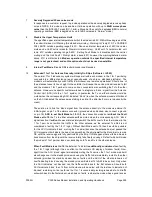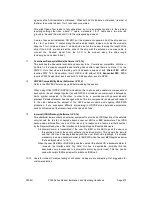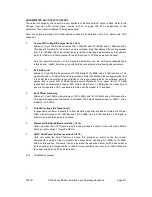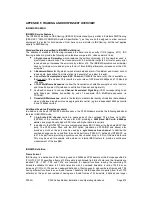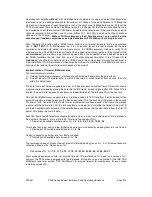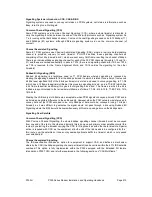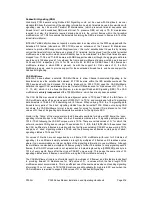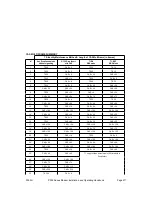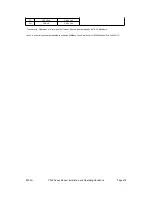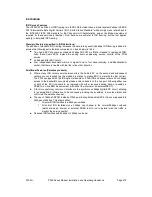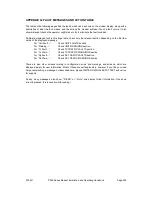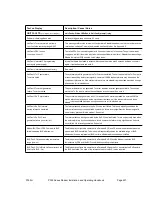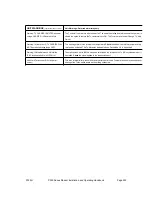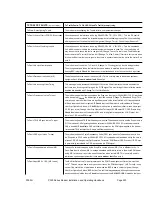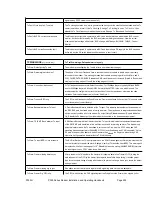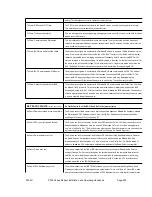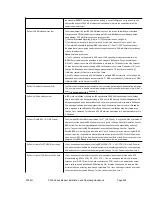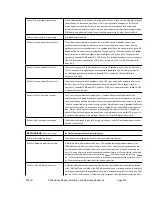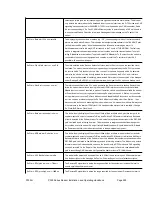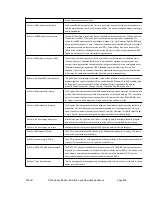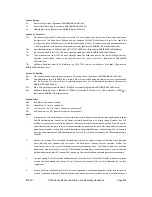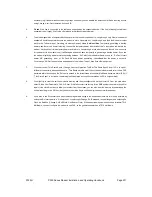
P300H
P300 Series Modem Installation and Operating Handbook
Page 223
TX TRAFFIC FAULTS
(Top line of display)
Tx Traffic Faults: Tx OK LED Off and Tx Traffic (prompt) relay.
Tx Warn: Reconfiguring Tx path
The modem is reconfiguring the Tx path (after a user parameter change).
Tx Fault: <line> off, terr <DTE/DCE> not ready
<line> depends on the interface in use (eg RS422 DCE= TR , V.35= DTR ). This is a DC control
line, which is used to indicate the terrestrial equipment is functioning properly. The <line> switching
off may be user set to cause this fault or be ignored (Change, Terr-Int, Control Lines).See note 5.
Tx Fault: <line> off, nothing to send
<line> depends on the interface in use (eg RS422 DCE= RS , V.35= RTS ). This is a handshake
line, which is used to indicate the terrestrial equipment has data to send. The <line> switching off
may be user set to cause this fault or be ignored (Change, Terr-Int, Control Lines). The Modem can
be set to mute the Tx carrier if this line is off (Change, Tx, Mod, Carrier). If carrier is set to mute when
this line is off but this line is set to ignore, then there is no alarm when this line mutes the carrier. See
note 5
Tx Fault: No clock from interface
The modem is set to use the Tx Clock In (Change, Tx, Clocking), but no clock is being provided.
The clock generation will use the internal clock as a backup to maintain the carrier and any
framing/ESC integrity.
Check
the data connector is attached and for activity on the clock input lines
Tx Fault: Data input is all ones (AIS)
The data supplied to the modem is all ones (AIS). This is normally used to indicate an upstream
equipment fault,
it is not a modem fault
. See note 4
Tx Fault: No Incoming Octet Timing
This message is only displayed if a 64kbps G.703 card is fitted. It indicates the card has detected
that there is no incoming octet timing on the G.703 signal. The monitoring of this octet timing may be
enabled and disabled with Change, Terr-Int, Card Specific.
Tx Fault: Frame sync lost on Tx input
The modem only detects frame sync when the Drop mux is active (or 2048k IBS G.732 0% overhead
mode is enabled).
Check
the bearer type is specified correctly (Change, Tx, Baseband, Drop). This
normally only occurs if either there are significant errors on the terrestrial link, or if it is supplied with
AIS and the modem is set to ignore AIS.
Check
that the AIS detector is not disabled with Change,
User-Opt, Operation, Actions, AIS.
ALSO
there is an option to make the modem re-seek frame sync
if CRC sync is lost (Change, User-Opt, Operation, Terrestrial, PCM Bearer CRC, CRC/Frame Acq ).
Check
the modem is not set to expect a CRC and forcing frame re-acquisition if CRC is lost, but
there is no CRC on the PCM signal.
Tx Fault: TS16 MF sync lost on Tx input
The modem only seeks TS16 Multiframe sync when the Tx baseband is set to use the Drop mux in a
G.732 mode and CAS signalling has been selected (or 2048k IBS G.732 0% overhead mode with
CAS is enabled).
Check
that a CAS multiframe is present on the PCM signal applied to the modem
(ie terrestrial TS16 contains the 16 frame multiframe sequence).
Tx Fault: CRC sync lost on Tx input
The modem only seeks Cyclic Redundancy Code (CRC) sync when the Tx baseband is set to use
the Drop mux in G.732 mode (or 2048k IBS G.732 0% overhead mode) and when set by the user to
process CRC s (Change, User-Opt, Operation, Terrestrial, PCM Bearer CRC, Process). If CRC sync
is permanently lost,
check
if a CRC is present on the PCM signal.
Tx Fault: Dropped data is all ones (AIS)
The specific timeslots dropped by the Drop Mux contain all ones (AIS). This is different to the Tx
Fault: Data input is all ones (AIS) message described earlier which refers to the whole PCM bearer
being AIS. In the case it is only the specific timeslots, which contain AIS. This is normally used to
indicate an upstream equipment fault,
it is not a modem fault
. See note 4
Tx Fault: Input BER > 1E-3, [AIS forced]
The Bit Error Rate at the Tx input (measured on the PCM Frame Alignment Words) is worse than
1x10
-3
. This can only be due to a very poor error rate on the PCM input signal. [AIS Forced] is only
shown if the user option of what action to take when the BER is bad is not set to Ignore (Change,
User-Opt, Operation, Actions, BER Action). The fault is always displayed, although the actions can
be cancelled by selecting Ignore.
Check
the line code setting (AMI/B8ZS/HDB3) matches the input
Содержание P300 Series
Страница 21: ...P300H P300 Series Modem Installation and Operating Handbook Page 21 F BLOCK DIAGRAM ...
Страница 22: ...P300H P300 Series Modem Installation and Operating Handbook Page 22 ...
Страница 163: ...P300H P300 Series Modem Installation and Operating Handbook Page 163 8 12 4 Eb No Explanatory Diagram ...

